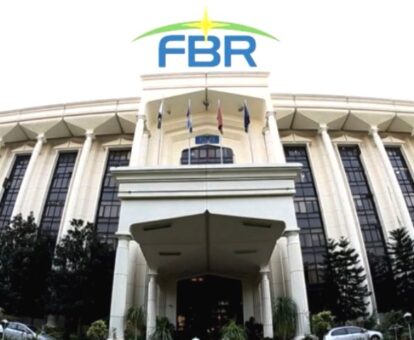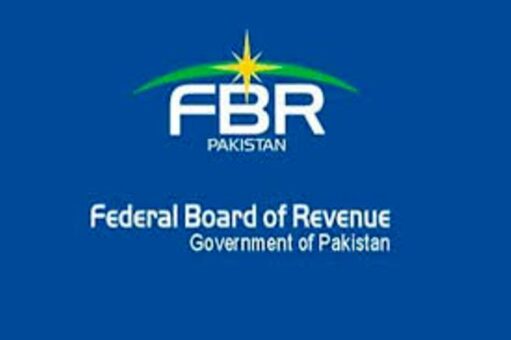The Federal Board of Revenue (FBR) in Pakistan has faced a shortfall in tax return submissions for the tax year 2021, despite significant spending on advertising and media campaigns aimed at encouraging taxpayers.
(more…)Tag: FBR
FBR, Pakistan’s national tax collecting agency, plays a crucial role in the country’s economy. Pakistan Revenue is committed to providing readers with the latest updates and developments regarding FBR activities.
-

Rate for profit on debt for Tax Year 2022
The Federal Board of Revenue (FBR) has disclosed the tax rates applicable to profit on debt under section 7B of the Income Tax Ordinance, 2001, for the tax year 2022.
(more…) -

Rate of dividend tax for Tax Year 2022
The tax rates for dividend tax imposed under section 5 of the Income Tax Ordinance, 2001 for tax year 2022 under the First Schedule of the Income Tax Ordinance, 2001.
The Federal Board of Revenue (FBR) issued the Income Tax Ordinance, 2001 updated up to June 30, 2021. The Ordinance incorporated amendments brought through Finance Act, 2021.
Following are the rates of dividend tax:
The rate of tax imposed under section 5 on dividend received from a company shall be-
(a) 7.5% in the case of dividends paid by Independent Power Producers where such dividend is a pass through item under an Implementation Agreement or Power Purchase Agreement or Energy Purchase Agreement and is required to be re-imbursed by Central Power Purchasing (CPPA-G) or its predecessor or successor entity.
(b) 15% in mutual funds, Real Estate Investment Trusts and cases other than those mentioned in clauses (a) and (c).
(c) 25% in case of a person receiving dividend from a company where no tax payable by such company, due to exemption of income or carry forward of business losses under Part VIII of Chapter III or claim of tax credits under Part X of Chapter III.
(Disclaimer: The text of the above section is only for information. Team PkRevenue.com makes all efforts to provide the correct version of the text. However, the team PkRevenue.com is not responsible for any error or omission.)
-

Hopes for further return filing date extension
ISLAMABAD: Today October 15, 2021 is the last date for filing return or income for tax year 2021. However, a large number persons still require to file their returns. They hope the FBR may further extend the last date beyond October 15, 2021.
(more…) -

GST exemption on various goods may be withdrawn
Pakistan’s Federal Board of Revenue is likely to withdraw exemption and concession of general sales tax (GST) granted on many consumable items.
The consumption tax may be withdrawan on the supply of goods to generate an estimated revenue of Rs334 billion, news reports suggested.
The exemption of GST may be withdrawn on supplies of various local and imported goods. The exemption and concession of consumption tax may continue on basic food items.
The report suggested that Personal Income Tax (PIT), there are 11 slabs and one proposal under consideration is to bring down slabs to 6 or 7 where the minimum taxable ceiling of Rs0.6 million might be adjusted upward while the rate of higher-income brackets might be increased.
The hike in power tariff to the tune of Rs1.40 per unit might be notified after the agreement with the IMF.
Federal Minister for Finance Shaukat Tarin is expected to hold a meeting with the IMF’s Managing Director (MD) Kristalina Georgieva on October 15, 2021 in Washington, DC. However, things are still unclear whether Pakistan and the IMF will be able to strike a staff-level agreement or not. The review talks may be extended if both sides remained unable to strike any staff-level agreement on the completion of the sixth and seventh reviews under the $6 billion Extended Fund Facility (EFF).
Sources said that the IMF was advising stringent taxation measures but Pakistani authorities were making last-ditch efforts to convince the IMF for delaying taxation measures on account of withdrawal of sales tax exemptions and adjustment into Personal Income Tax till the announcement of the next budget 2022-23 or implementation of these steps in a staggered manner.
-

Rate of super tax for Tax Year 2022
The Federal Board of Revenue (FBR) has defined the super tax rate for the tax year 2022 under the First Schedule of the Income Tax Ordinance, 2001.
(more…) -

Rates of income tax for companies during Tax Year 2022
The tax rates for corporate entities for tax year 2022 under the First Schedule of the Income Tax Ordinance, 2001.
The Federal Board of Revenue (FBR) issued the Income Tax Ordinance, 2001 updated up to June 30, 2021. The Ordinance incorporated amendments brought through Finance Act, 2021.
Following are the rates of tax for corporate entities:
(i) The rate of tax imposed on the taxable income of a company for the tax year 2007 and onward shall be 35%:
Provided that the rate of tax imposed on the taxable income of a company other than a banking company, shall be 34% for the tax year 20145:
Provided further that the rate of tax imposed on the taxable income of a company, other than a banking company, shall be 33% for the tax year 2015:
“Provided further that the rate of tax imposed on taxable income of a company, other than banking company shall be 32% for the tax year 2016, 31% for tax year 2017, 30% for tax year 2018 and 29% for tax year 2019 and onwards.
(iii) where the taxpayer is a small company as defined in section 2, tax shall be payable at the rate of 25%:
Provided that for tax year 2019 and onwards tax rates shall be as set out in the following Table, namely:—
Tax year Rate of Tax 2019 24% 2020 23% 2021 22% 2022 21% 2023 and onwards 20%”; (Disclaimer: The text of the above section is only for information. Team PkRevenue.com makes all efforts to provide the correct version of the text. However, the team PkRevenue.com is not responsible for any error or omission.)
-

Rate of tax for salaried persons for tax year 2022
The tax rates for salaried persons for tax year 2022 under the First Schedule of the Income Tax Ordinance, 2001.
The Federal Board of Revenue (FBR) issued the Income Tax Ordinance, 2001 updated up to June 30, 2021. The Ordinance incorporated amendments brought through Finance Act, 2021.
Following are the rates of tax for salaried persons during tax year 2022 (July 01, 2021 – June 30, 2022):
(2) Where the income of an individual chargeable under the head “salary” exceeds seventy-five per cent of his taxable income, the rates of tax to be applied shall be as set out in the following table, namely:—
TABLE S. No. Taxable income Rate of tax (1) (2) (3) 1. Where taxable income does not exceed Rs. 600,000 0% 2. Where taxable income exceeds Rs. 600,000 but does not exceed Rs. 1,200,000 5% of the amount exceeding Rs. 600,000 3. Where taxable income exceeds Rs. 1,200,000 but does not exceed Rs. 1,800,000 Rs. 30,000 plus 10% of the amount exceeding Rs. 1,200,000 4. Where taxable income exceeds Rs. 1,800,000 but does not exceed Rs. 2,500,000 Rs. 90,000 plus 15% of the amount exceeding Rs. 1,800,000 5. Where taxable income exceeds Rs.2,500,000 but does not exceed Rs. 3,500,000 Rs. 195,000 plus 17.5% of the amount exceeding Rs. 2,500,000 6. Where taxable income exceeds Rs. 3,500,000 but does not exceed Rs. 5,000,000 Rs. 370,000 plus 20% of the amount exceeding Rs. 3,500,000 7. Where taxable income exceeds Rs. 5,000,000 but does not exceeds Rs. 8,000,000 Rs. 670,000 plus 22.5% of the amount exceeding Rs. 5,000,000 8. Where taxable income exceeds Rs. 8,000,000 but does not exceeds Rs. 12,000,000 Rs. 1,345,000 plus 25% of the amount exceeding Rs. 8,000,000 9. Where taxable income exceeds Rs. 12,000,000 but does not exceeds Rs. 30,000,000 Rs. 2,345,000 plus 27.5% of the amount exceeding Rs. 12,000,000 10. Where taxable income exceeds Rs. 30,000,000 but does not exceeds Rs. 50,000,000 Rs. 7,295,000 plus 30% of the amount exceeding Rs. 30,000,000 11. Where taxable income exceeds Rs. 50,000,000 but does not exceeds Rs. 75,000,000 Rs. 13,295,000 plus 32.5% of the amount exceeding Rs. 50,000,000 12. Where taxable income exceeds Rs. 75,000,000 Rs. 21,420,000 plus 35% of the amount exceeding Rs. 75,000,000] (Disclaimer: The text of the above section is only for information. Team PkRevenue.com makes all efforts to provide the correct version of the text. However, the team PkRevenue.com is not responsible for any error or omission.)
-

Tax rates for individuals, AOPs for Tax Year 2022
The tax rates for individuals and Association of Persons (AOPs) for tax year 2022 under the First Schedule of the Income Tax Ordinance, 2001.
The Federal Board of Revenue (FBR) issued the Income Tax Ordinance, 2001 updated up to June 30, 2021. The Ordinance incorporated amendments brought through Finance Act, 2021.
Following are the rates of tax for Individuals and Association of Persons:
(1) Subject to clause (2), the rates of tax imposed on the income of every individual and association of persons except a salaried individual shall be as set out in the following Table, namely:—
TABLE S. No. Taxable income Rate of tax (1) (2) (3) 1. Where taxable income does not exceed Rs. 400,000 0% 2. Where the taxable income exceeds Rs. 400,000 but does not exceed Rs. 600,000 5% of the amount exceeding Rs. 400,000 3. Where taxable income exceeds Rs. 600,000 but does not exceed Rs. 1,200,000 Rs. 10,000 plus 10% of the amount exceeding Rs. 600,000 4. Where taxable income exceeds Rs.1,200,000 but does not exceed Rs. 2,400,000 Rs. 70,000 plus 15% of the amount exceeding Rs. 1,200,000 5. Where taxable income exceeds Rs. 2,400,000 but does not exceed Rs. 3,000,000 Rs. 250,000 plus 20% of the amount exceeding Rs. 2,400,000 6. Where taxable income exceeds Rs. 3,000,000 but does not exceed Rs. 4,000,000 Rs. 370,000 plus 25% of the amount exceeding Rs. 3,000,000 7. Where taxable income exceeds Rs. 4,000,000 but does not exceed Rs. 6,000,000 Rs. 620,000 plus 30% of the amount exceeding Rs. 4,000,000 8. Where taxable income exceeds Rs. 6,000,000 Rs. 1,220,000 plus 35% of the amount exceeding Rs. 6,000,000 (Disclaimer: The text of the above section is only for information. Team PkRevenue.com makes all efforts to provide the correct version of the text. However, the team PkRevenue.com is not responsible for any error or omission.)
-

Trade discount should be displayed on invoice: FBR
ISLAMABAD: The Federal Board of Revenue (FBR) on Thursday said that trade discount if any to be given by a retailer has to be depicted on the invoice horizontally i.e. from left to right
The FBR on August 9, 2021 issued SRO 1006(I)/2021 and specified standardized format for sales tax invoice detailing minimum requirement for the integrated point of sale (POS) system.
The definition of trade discount as mentioned in the value of supply in sub-section (46) of Section 2 the Sales Tax Act, 1990 is meant for Business to Business transactions and does not cover retail sector and the business to consumer transaction.
The FBR said it had received various representations from the taxpayers and Bar Councils seeking clarification of the term ‘trade discount’ as stated in sub-section (46) of Section 2 of the Sales Tax Act, 1990 whether the term also covers ‘cash discount’ given by retailers to end consumers, for the purpose of depiction in the standardized Sales Tax invoice under SRO 1006(1)/2021 dated 09.08.2021.
The matter has been examined by the Board, it is clarified that the discount if any to be given by a retailer has to be depicted on the invoice horizontally i.e. from left to right.
The captions such as total, sales tax paid, discount allowed appearing at the bottom of the invoice are standalone notations and do not necessarily add or subtract one another.